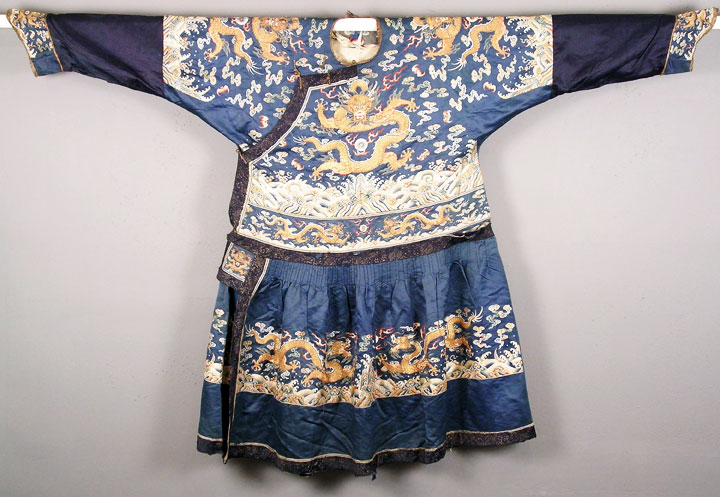The USC Pacific Asia Museum, which includes representative examples of art from Asia and the Pacific Islands spanning more than 4,000 years, is just west of Old Town Pasadena.
To step into the courtyard, hard to do by busy Los Robles Avenue, is to step into a quieter, more ancient world. Green-glazed roof tiles, pagoda windows, decorative archways. The faint whiff of incense.
Through Jan. 6, 2019, the museum is featuring a splendid exhibit: “Ceremonies and Celebrations,” comprising textile treasures from its permanent collection. Because of their fragile nature, the treasures are displayed sparingly.
The exhibit is arranged by themes of identity and meaning rather than geography. So India mingles with Bhutan mingles with China mingles with India and beyond.
Upon entering, you’re greeted by a fantastic outfit that turns out to be a fireman’s jacket. Geometrically cut and styled out of a heavy mesh velvet fabric, the colors are indigo blue and taupe, and the back features a large insignia identifying the man’s brigade.
From pre-modern Japan, the jacket was worn with close-fitting trousers, gloves and a hood, marking the wearer out as a practitioner of his honorable livelihood. When fighting a fire, the jacket was worn inside out to reveal an unadorned side and first soaked to protect against embers and flame.
Once the fire was extinguished, the fireman again reversed the jacket as a sign of success.
Who doesn’t want to know such things! And who wouldn’t want to wear this jacket — sumptuous, stylish, classic, and classy — on, say, a Sunday morning while reading in bed?
OK, maybe you’re either crazy for textiles or you’re not. I happen to be, possibly because my dear departed mother was an expert seamstress, possibly because textiles are tactile and gorgeous, and possibly because the people who made them are so often anonymous, hidden, lost to posterity.
Here are the objects come to life from beloved children’s books. A set of imperial armor (silk brocade with gold-gilt bronze embellishments) and an extraordinary iron decorated helmet with pale blue rivet-adorned ear flaps from 18th-century China.
A wedding hat, also from China, a fabulous beanie of royal blue, scarlet and gold, cuffed with luxurious black seal fur. A diadem of gold and silver silk embroidered with the five cosmic Buddhas and worn by monks during initiation ceremonies.
It’s impossible to convey the fineness and sophistication of the work. You just have to go see it and gasp. A man’s Indonesian hip cloth, worked in black and white, featuring rows of stylized roses and a fringe. A silk velvet throne cover startlingly bordered by swastikas: a sign of longevity and blessings during China’s Qianlong period (1736-1795).
From Bhutan has emerged an exquisitely patterned 20th-century hand wash lap cover (“chagsi pangkheb”). Again, why haven’t we, with our supposedly advanced civilization, followed suit? Who does not need basically a 10-foot napkin, borne by an attendant, to wipe up crumbs, spills, and other assorted daily accidents?
One of my favorite pieces was a woman’s robe for Korean funeral ceremonies, of a lightly starched gauzy fabric the color of old parchment. Though ostensibly for mourners, the garment, to my mind, would have segued nicely into the coffin and done a corpse proud, too.
Here was just the outfit in which to enter heaven, undergo a light anointing, and recline into that long rest we never quite found time for on earth.
Afterward I went and sat for a bit in the courtyard. Koi swam languidly in a stone pool.
Surrounded by gingko trees, bamboo, and azaleas, I prayed the rosary, as Pope Francis invited us to do during the month of October, “and thus to join in communion and in penitence, as the people of God, in asking the Holy Mother of God and St. Michael Archangel to protect the Church from the devil, who always seeks to separate us from God and from each other.”
In one way writing this column each week is the easiest job in the world and in another, the job takes everything I have: physically, mentally, emotionally, spiritually. I’m not just gadding about to concerts and museums and talking to interesting artists of various stripes and reading books.
Every week I prepare my heart. Every week I bring to bear all my attention, all my powers of observation and discernment, all my longing for connection. Every week I know my column will be read by a few, quickly forgotten, and more or less vanish in the mist.
To go to a museum — when all around angry people are telling us to take sides, take action, take umbrage — is to stake a life on the invitatory that calls us to the Divine Office each morning: “Lord, open my lips. And my mouth will proclaim your praise.”
It is to have a very particular idea of what matters in this world: what registers, what bears fruit, what endures.
All the way home I thought about how not one of the artists and craftspeople who had created the textiles I’d seen was identified. Those anonymous laborers of love had sown the seeds of beauty and left the harvest to us.
Heather King is a blogger, speaker and the author of several books. For more, visit heather-king.com.
SPECIAL OFFER! 44 issues of Angelus for just $9.95! Get the finest in Catholic journalism with first-rate analysis of the events and trends shaping the Church and the world, plus the practical advice from the world’s best spiritual writers on prayer and Catholic living, along with great features about Catholic life in Los Angeles. Subscribe now!

